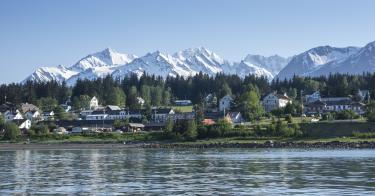In only a matter of weeks, COVID-19 managed to spread from China to the entire world, including the seemingly out-of-reach High North.
Like every other affected region, the Arctic faces its own challenges with the coronavirus pandemic. This is particularly true of the North American Arctic, which consists of Alaska, the northern parts of Canada, and Greenland.
The Arctic, like much of the rest of the world, has a long history of dealing with global pandemics, with the Spanish flu being the most deadly.
>>> What’s the best way for America to reopen and return to business? The National Coronavirus Recovery Commission, a project of The Heritage Foundation, assembled America’s top thinkers to figure that out. So far, it has made more than 260 recommendations. Learn more here.
By 1920, the Spanish flu had killed up to 3,000 Alaskans, 8% of the Alaskan indigenous population, and one-third of the northern Canadian Inuit population. In some communities within Alaska and the Labrador province in Canada, the mortality rate was as high as 90%.
Thus far, compared to the Spanish flu, COVID-19 hasn’t seriously affected the North American Arctic. In fact, the most Arctic portions of the continent have seen significantly less death than the non-Arctic regions.
Alaska, for example, has fewer cases and fewer deaths from COVID-19, the disease caused by the new coronavirus, than any other state in the U.S.
In total, Greenland had 11 total cases, all of which now are recovered fully. Northern Canada has seen 16 cases: five in the Northwest Territory and 11 in Yukon. None has resulted in death.
But why has Arctic North America been less affected by COVID-19.
The simple answer: It’s remote.
With some towns spaced hundreds of miles apart, sometimes unconnected by roads, the remote nature of the Arctic is a double-edged sword: These towns are more isolated and therefore easier to protect, but are also so much more vulnerable if precautionary measures fail.
In the case of COVID-19, the virus has been contained within larger cities.
Greenland, for example, was able to eliminate all cases quickly by isolating an infected person and his close contacts in the capital city of Nuuk. In Greenland, no two villages or cities are connected by roads, and the virus did not manage to travel. Within two weeks, all were recovered, allowing the city to reopen in April.
The stakes are especially high in Alaska, particularly for northern indigenous groups. Much like Greenland, this region lacks adequate infrastructure. Many would be surprised to learn that despite being part of the United States, more than 3,000 rural Alaskans don’t have running water or proper plumbing and sanitation, which puts them at critical risk during a global pandemic.
Due to overcrowding in small homes, rural Alaskans are highly susceptible to the rapid spread of infection. Because of these risks, extra precautions have been taken to prevent outsiders from entering the more remote villages.
There are three common ways to visit Alaska: by cruise ship, by plane, and by car from Canada. With no cruise ships running and the Canadian border closed, the only traffic into Alaska has been by plane. Testing prior to entry has increased, especially in small, local airports.
On May 19, an asymptomatic passenger arriving at Kotzebue’s airport in the Northwest Arctic borough of Alaska submitted to testing, turned out positive, and immediately was put into quarantine. Without the increase in airport testing, this asymptomatic case would have made its way into the small Arctic city of 3,000 residents.
Even before COVID-19 struck, residents of Arctic Canada suffered from a lack of mental health resources, a housing crisis resulting in overcrowding, long distances to hospitals, and food insecurity.
Currently, Nunavut is the only Canadian province without a coronavirus case. In the rest of northern Canada, much like in Greenland, all positive cases were isolated to larger cities and resolved. Similar to Alaska, northern Canadian provinces have created travel restrictions on incoming flights to keep residents safe.
Places such as Arctic Alaska, Canada, and Greenland have reacted with such extreme measures because they can clearly see the unique danger that COVID-19 poses in the region. A continuation of tightly closed borders, airport testing, and perhaps geographical pinpoint testing will help rural Arctic villages in self-isolation and hopefully fend off COVID-19 from entering these vulnerable communities.
Arctic residents look back on the devastation caused by previous pandemics such as the Spanish flu and are motivated to prevent the same thing from happening again. Quick reaction time and the willingness to shut borders and even close off individual towns—along with the region’s remoteness—have so far protected them from the ravages of COVID-19.
This piece originally appeared in The Daily Signal



